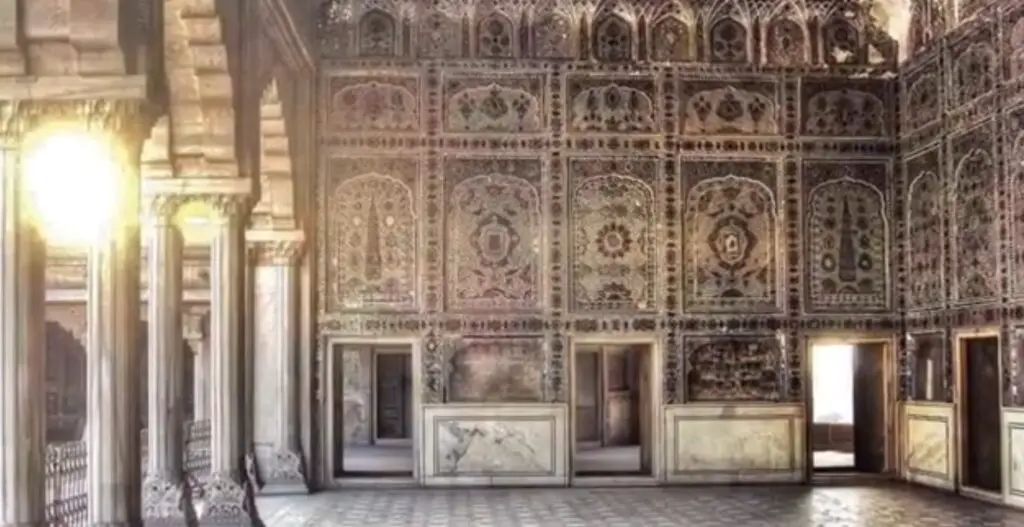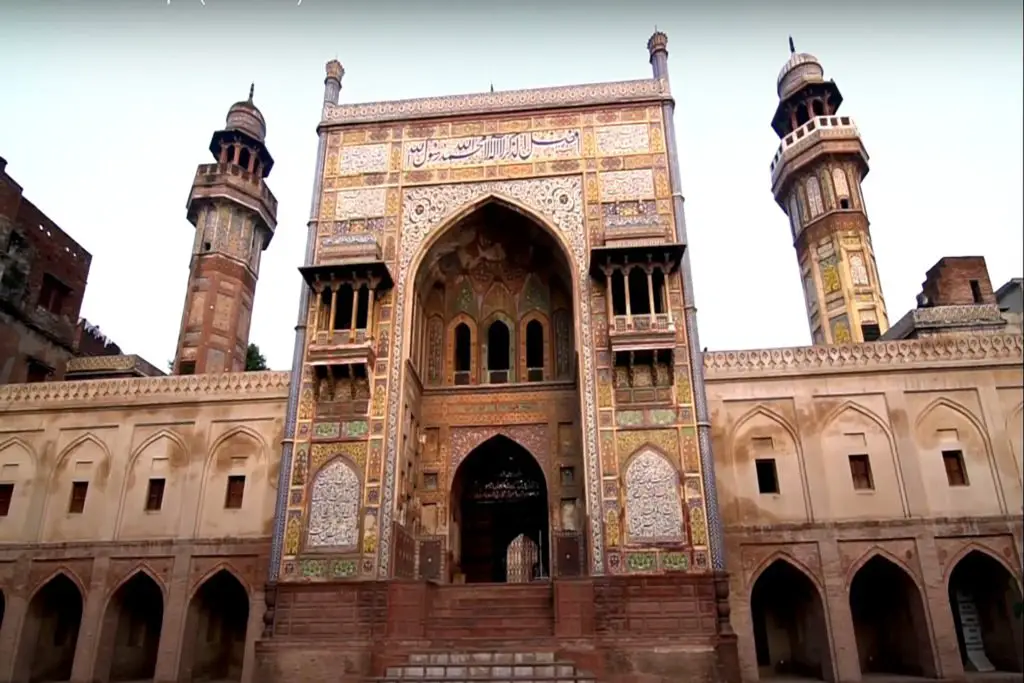Sheesh Mahal, or the Palace of Mirrors, is a stunning piece of Mughal architecture located within the Lahore Fort in Lahore (Punjab), Pakistan. It was built in the mid-17th century during the reign of Emperor Shah Jahan, who is also known for commissioning the Taj Mahal in Agra.
The Sheesh Mahal is not only known for its beauty but also for its historical significance. It was within this palace that the famous diamond, Koh-i-Noor, was kept before it was taken by the British during their colonial rule of India. The diamond is now part of the British Crown Jewels.
The Sheesh Mahal is a popular tourist destination and attracts visitors from all over the world. Its beauty and historical significance have made it a symbol of Pakistan’s rich cultural heritage.
Sheesh Mahal Location
Sheesh Mahal is a palace located in the Shah Burj block in the northwest corner of the Lahore Fort. It was built during the reign of the Mughal Emperor Shah Jahan in 1631–32, with some additions later under the Sikh Maharaja Ranjit Singh.
The ornate white marble pavilion is an inlaid pietra dura and complex mirror work of the finest quality. The hall was reserved for the personal use of the imperial family and close aides. It is among the 21 monuments built by successive Mughal emperors inside the Lahore Fort. As part of the larger Lahore Fort complex, it has been a UNESCO World Heritage Site since 1981.
Sheesh Mahal literally means “Palace of Crystals” in Urdu. However, due to its pietra dura decorations and intricate mirror decorations inlaid into the white marble walls and ceilings creating a luminous effect, the opulent room became known as the “Palace of Mirrors” and sometimes the “Hall”. Similar halls are also found in the present palace of the Agra Fort and show the influence of the later additions of the Amber Fort.
Sheesh Mahal Lahore Architecture
The Sheesh Mahal is known for its intricate mirror work, which covers the walls and ceiling of the palace. The mirrors are so delicately placed that a single candle could light up the entire room. The palace was designed to be a private chamber for the emperor and his queen, and the mirror work was meant to reflect the candlelight and create a mesmerizing effect.
The exterior of the Sheesh Mahal is relatively simple, with a white marble facade and a small dome on top. However, the real beauty of the palace lies within. The interior is divided into three chambers: the central chamber, the sleeping chamber, and the dressing chamber. Each chamber is decorated with a different pattern of mirrorwork, creating a unique and captivating atmosphere.
The central chamber is the largest of the three and features a large pool in the center. The pool was designed to reflect the intricate mirror work, creating the illusion of an infinite sea of light. The sleeping chamber is located behind the central chamber and is where the emperor and his queen would rest. The walls and ceiling of this chamber are covered in small pieces of mirror that create a stunning mosaic-like effect. The dressing chamber is located on the opposite side of the central chamber and was where the queen would get ready for her day.
Sheesh Mahal was built by Emperor Shah Jahan. It was built in the middle of Jahangir’s reign. The facade, consisting of five vaulted marble arches supported by coupled columns, opens into the courtyard. Engraved parapets and pedestals are inlaid with precious stones.
The pavilion is half-octagonal in shape and consists of apartments roofed with gilded domes and intricately decorated pietra dura and convex glass and mirror mosaics (Ayina Kari) with thousands of small mirrors.
They light candles at night. Decorative features also include stucco tracery (Munabat Kari) and carved marble screens in geometric and tendril designs. The roof of the central hall rises up to two floors. The hall was originally decorated with frescoes, which were later replaced by glass mosaics in different colors.
The Sheesh Mahal has five arched entrances that allow visitors to be mesmerized by the shimmering and reflective properties of the hundreds of thousands of mirrors on the walls and ceiling. The verandah is just a facade, as the ornate bedroom of Shah Jahan and Mumtaz lies far behind, tucked nicely among a cluster of other rooms.
The bedroom has an opulent star-shaped ceiling studded with crystals that glow in the dark. To think that the traces of gold frames and lines, now freshly painted, were actually gilded, red plastic-glass crystals and blue ornaments must have recently been set into the wall structures to fill in the looted rubies, emeralds, lapis lazuli, and sapphires, is stunning.
The mirrors of the Sheesh Mahal are so reflective and powerful that only two candles can light up the entire Sheesh Mahal. When the place is lit up at night with battery-operated candles, from a distance it glistens like a giant disco ball.
Right outside is a fountain square with a small raised platform in the middle that can be accessed by a walkway. When the moon is full, it shines directly on the platform and the gushing fountains scatter the light and reflect it on the mirrors of the Sheesh Mahal.
History of Sheesh Mahal
Mumtaz Mahal, whose real name was Arjumand Bano Begum, was born in the house of a Persian, Asif Khan, the brother of Empress Nur Jehan and the son of Itemadud Daula, Jehangir’s confidant. Just as Jehnagir met and fell in love with Nur at the annual Meena Bazaar in the Fort
The love story behind its construction is as unique as its structure. The Palace of Mirrors or Sheesh Mahal was built under the supervision of Asif Khan for Emperor Shah Jahan in 1631-32 AD. It is said that Shah Jahan had it built for his beloved Queen Mumtaz Mahal when she lived in Lahore.
So richly flamboyant would the emperor express his love for his beloved queen who tried to make her dreams come true. Mumtaz could not live to witness the completion of the Sheesh Mahal, but nevertheless, the Sheesh Mahal will be associated with her romance with Shah Jahan for all future ages.
Unfortunately, before she could enter the palace, she died and Shah Jahan had to order the construction of the Taj Mahal in India. According to the references, she died in 1631 and the palace was completed in 1632, leaving Shah Jahan heartbroken.
Today, visitors to the Sheesh Mahal can experience the palace’s beauty firsthand. The palace is open to the public and is a popular destination for both locals and tourists. Visitors can walk through the palace’s chambers and marvel at the intricate mirror work that covers the walls and ceiling. The pool in the central chamber still reflects the light in a mesmerizing way, just as it did centuries ago.
In addition to its historical and cultural significance, the Sheesh Mahal is also a symbol of Pakistan’s rich artistic heritage. The intricate mirror work is a testament to the skill and craftsmanship of the Mughal artisans who created it. The palace serves as a reminder of the importance of preserving Pakistan’s cultural heritage for future generations.
The Sheesh Mahal has undergone extensive restoration work in recent years, and it has been restored to its former glory. Visitors can now experience the beauty of this magnificent palace and marvel at the intricate mirror work that has survived for centuries.
In conclusion, the Sheesh Mahal in Lahore is a true masterpiece of Mughal architecture and a testament to the rich cultural heritage of Pakistan. It is a must-visit for anyone interested in history, art, and architecture. The palace’s intricate mirror work is a testament to the skilled craftsmen of the Mughal era and continues to mesmerize visitors to this day.







